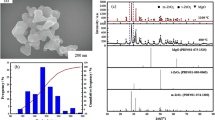Abstract
The fast densification method of combustion reaction plus quick pressing was adopted to prepare nanocrystalline ceramics. The densification process of magnesia compact with a particle size of 100 nm was investigated, under the applied pressure of up to 170 MPa, and the temperature range of 1740–2080 K with ultra-high heating rate (above 1700 K/min). High-purity magnesia ceramics with a relative density of 98.8% and an average grain size of 120 nm was obtained at 1740 K, and the grain growth during the densification process was effectively restrained. The characteristic morphology of evaporation-condensation was observed in the compact prepared at 2080 K, which revealed the actual process of mass transfer by gas diffusion. Moreover, the investigation on the microstructure evolution and mechanism of grain growth was carried out, on the basis of as-preserved nanocrystalline ceramics. The result indicated that the grain growth of the nanocrystalline MgO was controlled by the mechanism of evaporation-condensation rather than surface diffusion. Furthermore, the pressure had an influence of restraining the grain growth based on solid diffusion and strengthening the effect of gas diffusion with the increasing temperature. Under the particular conditions, there existed an appropriate temperature for the densification of nanocrystalline magnesia, while the excessive temperature would exaggerate grain growth and impede densification.
Similar content being viewed by others
References
Gleiter H. Nanostructured materials: Basic concepts and microstructure. Acta Mater, 2000, 48: 1–29
Lange F F. Densification of powder compacts: An unfinished story. J Eur Ceram Soc, 2008, 28: 1509–1516
Yoshida H, Kodo M, Soga K, et al. Doping effect on sinterability of polycrystalline yttria: From the viewpoint of cation diffusivity. J Eur Ceram Soc, 2012, 32: 3103–3114
Chen I W, Wang X H. Sintering dense nanocrystalline ceramics without final-stage grain growth. Nature, 2000, 404: 168–171
Oghbaei M, Mirzaee O. Microwave versus conventional sintering: A review of fundamentals, advantages and applications. J Alloys Compd, 2010, 494: 175–189
Chaim R, Levin M, Shlayer A, et al. Sintering and densification of nanocrystalline ceramic oxide powders: A review. Adv Appl Ceram, 2008, 107: 159–169
Munir Z A, Anselmi-Tamburini U, Ohyanagi M. The effect of electric field and pressure on the synthesis and consolidation of materials: A review of the spark plasma sintering method. J Mater Sci, 2006, 41: 763–777
Marder R, Chaim R, Estournès C. Grain growth stagnation in fully dense nanocrystalline Y2O3 by spark plasma sintering. Mater Sci Eng A, 2010, 527: 1577–1585
Meng F C, Fu Z Y, Zhang J Y, et al. Rapid densification of nano-grained alumina by high temperature and pressure with a very high heating rate. J Am Ceram Soc, 2007, 90: 1262–1264
Fu Z Y, Huang L W, Zhang J Y, et al. Ultra-fast densification of CNTs reinforced alumina based on combustion reaction and quick pressing. Sci China Tech Sci, 2012, 55: 484–489
Chaim R. Densification mechanisms in spark plasma sintering of nanocrystalline ceramics. Mater Sci Eng A, 2007, 443: 25–32
Munir Z A, Anselmi-Tamburini U. Self-propagating exothermic reaction: The synthesis of high-temperature materials by combustion. Mater Sci Rep, 1989, 3: 277–358
Merzhanov A G. Self-propagating high-temperature synthesis: Twenty years of search and findings. In: Munir Z A, Holt J B, eds. Combustion and plasma synthesis of high-temperature materials. Lect Notes in August. New York: VCH Publishing Inc, 1990. 1–53
Ehre D, Gutmanas Y, Chaim R. Densification of nanocrystalline MgO ceramics by hot-pressing. J Eur Ceram Soc, 2005, 25: 3579–3585
Gupta T K. Sintering of MgO: Densification and grain growth. J Mater Sci, 1971, 6: 25–32
Mohamed F A. Interpretation of superplastic flow in terms of a threshold stress. J Mater Sci, 1983, 18: 582–592
Boo J H, Lee S B, Yu K S, et al. Growth of magnesium oxide thin films using single molecular precursors by metal-organic chemical vapor deposition. Thin Solid Films, 1999, 341: 63–67
Kingery W D, Berg M. Study of the initial stages of sintering of solids by viscous flow, evaporation-condensation, and self-diffusion. J Appl Phys, 1955, 26: 1205–1212
Akash A, Mayo M J. Pore growth during initial-stage sintering. J Am Ceram Soc, 1999, 82: 2948–2952
Kleiman S, Chaim R. Thermal stability of MgO nanoparticles. Mater Lett, 2007, 61: 4489–4491
Vieira J M, Brook R J. Lattice, grain-boundary, surface and gas-diffusion constants in magnesium oxide. In: Kingery W D, ed. Structure and properties of MgO and Al2O3 ceramics. Columbus: American Ceramic Society, 1984. 438–463
Arzt E, Ashby M F, Verrall R A. Interface controlled diffusional creep. Acta Metall, 1983, 31: 1977–1989
Kingery W D, Francis B. Grain growth in porous compacts. J Am Ceram Soc, 1965, 48: 546–547
Herring C. Effect of change of scale on sintering phenomena. J Appl Phys, 1950, 21: 301–303
Mullins W W. Theory of thermal grooving. J Appl Phys, 1957, 28: 333–339
Coble R L. Diffusion models for hot pressing with surface energy and pressure effects as driving force. J Appl Phys, 1970, 41: 4798–4807
Author information
Authors and Affiliations
Corresponding author
Rights and permissions
About this article
Cite this article
Liu, J., Fu, Z., Wang, W. et al. Microstructural evolution and mechanism of grain growth in magnesia ceramics prepared by high pressure and temperature with ultra-high heating rate. Sci. China Technol. Sci. 57, 1085–1092 (2014). https://doi.org/10.1007/s11431-014-5518-0
Received:
Accepted:
Published:
Issue Date:
DOI: https://doi.org/10.1007/s11431-014-5518-0




